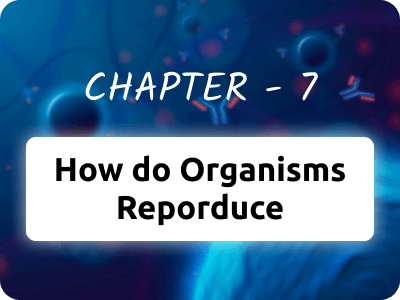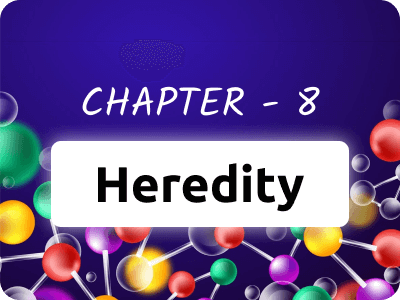Key Topics Covered
Reproduction is a biological process through which organisms create new individuals similar to themselves. Unlike essential processes like nutrition or respiration, reproduction is not necessary for an individual’s survival. However, it plays a critical role in ensuring the continuity of species and maintaining their population. Organisms reproduce by creating copies of their DNA, which serves as the blueprint for body designs and functions. While DNA copying is generally reliable, minor variations occur due to the inherent nature of biochemical processes. These variations are vital for the evolution and survival of species, as they allow organisms to adapt to environmental changes.
For instance, in changing ecological niches, organisms with beneficial variations are more likely to survive and reproduce. This process helps maintain ecosystem stability and ensures species' resilience against challenges like climate change or habitat alterations. Thus, reproduction and variation are interconnected, forming the foundation of biodiversity and evolution.
- Fission
Fission is also known as Cell Division, and is the process of creation of new organisms in unicellular organisms. - Fragmentation
Fragmentation is a form of asexual reproduction where an organism breaks into smaller pieces. Then each piece grows into a new individual. - Regeneration
Regeneration is the process where an organism can grow new individuals from its body parts if cut or broken into pieces. - Budding
Budding is a form of asexual reproduction where a new organism develops from an outgrowth of the parent. - Vegetative Propagation
Vegetative Propagation is a form of asexual reproduction. It is where plants grow new individuals from parts like roots, stems, or leaves. - Spore Formation
Spore formation is a method of reproduction in certain organisms where spores develop into new individuals.
Sexual reproduction is a biological process where two individuals contribute their genetic material to produce a new organism. This involves the fusion of specialized reproductive cells called gametes – the male gamete (typically motile) and the female gamete (containing stored energy). The DNA in these gametes is halved through a process called meiosis, ensuring that when they combine, the resulting zygote has the correct amount of DNA.
This method of reproduction not only maintains genetic stability across generations but also promotes genetic variation by combining DNA from two distinct individuals. These variations, accumulated over generations, play a crucial role in the survival and adaptability of a species. Sexual reproduction is a cornerstone of diversity in life forms, especially in complex organisms.
- Reproductive Parts: Stamens (male) produce pollen; pistil (female) contains the ovary, style, and stigma.
- Pollination: Pollen transfer can be self-pollination or cross-pollination.
- Fertilization: Pollen fuses with the egg cell in the ovule, forming a zygote that develops into an embryo.
- Post-fertilization: The ovule becomes a seed, and the ovary ripens into a fruit. Other flower parts may fall off.
- Germination: The seed grows into a new plant under suitable conditions.
During puberty, the body changes body hair growth, skin changes, and the development
of sexual characteristics. In females, menstruation begins, while in males, sperm
production starts, and the penis becomes capable of erection. Germ cells (sperm in
males and eggs in females) are formed for reproduction.
Male Reproductive System:
Sperm are produced in the testes, located in the scrotum to maintain a lower
temperature essential for sperm formation. Sperm travels through the vas deferens
and urethra, where fluids from the prostate and seminal vesicles add nutrition and
aid in transport.
Female Reproductive System:
Eggs are produced in the ovaries, which also secrete hormones. After puberty, one
egg matures monthly and travels through the oviduct to the uterus. Fertilization
occurs in the oviduct, forming a zygote that develops into an embryo and implants in
the uterine lining, nourished by a blood-rich uterus.
- Sexual maturity doesn’t always mean readiness for sexual activity or parenthood.
- Sexually transmitted diseases (STDs) like HIV and syphilis can be prevented with condoms.
- Pregnancy puts physical and mental strain on women, and contraception methods can prevent unwanted pregnancies.
- Contraceptive methods include condoms, birth control pills, and IUDs.
- Abortion and Misuse of sex-selective practices can harm the sex ratio.
Chapter at a Glance
Dive into the full chapter video – Download now!Why do students love Topperssky?

ToppersSky turned tough subjects into something exciting. I never thought studying could be this enjoyable.
-Bhavesh,
CBSE Class 10th

I used to fail science tests, but ToppersSky helped me improve my scores with their amazing videos.
-Chahat,
CBSE
Class 10th

With ToppersSky, I don’t feel like I’m studying. It’s like watching a movie and learning at the same time.
-Naveen,
CBSE
Class 10th

ToppersSky broke down complex ideas into fun and simple animations. I finally understand my subjects.
-Joycey,
CBSE
Class 10th

Scored 10 out of 20? Read the chapter on ToppersSky and improve your score to 18 out of 20! Don't settle for average-take the first step toward excellence today!
Start Learning NowAll Possible Question & Answer of Chapter 7
Still confused about the type of questions that might appear in the exam from Science Chapter 7: How Do Organisms Reproduce? ToppersSky's Minku and Minki Question & Answer section covers all possible questions from Chapter 7 with detailed, easy-to-understand answers. From asexual reproduction to the reproductive systems in humans, we've got you covered. Unlock this chapter now and ace your exams effortlessly.
Curious about Minku and Minki’s Q&A? Watch the full video exclusively on the ToppersSky app!
Explore the Chapter Now!PRICING
Affordable Learning for Everyone
SPECIAL OFFER
Refer 1 friend and unlock 1 chapter for FREE!

How to Write an Answer?
Struggling with how to structure your answers for better marks? ToppersSky provides expert guidance on writing clear, concise, and well-organized answers that impress examiners. Learn the perfect way to present your knowledge and score higher effortlessly!
Master answer writing skills – Watch the complete video on the ToppersSky app today!
Buy Full Chapter Now!Frequently Asked Questions
- Download the app from Play Store.
- Sign up and log in using your mobile number.
- Choose your educational board and class to access relevant content.
- Navigate to the dashboard to view all available chapters.
- Select the chapter you want and add it to your cart.
- Complete the payment process to finalize your purchase.
- Access and read the chapter after the purchase.
Yes, our content follows the CBSE and RBSE syllabi completely, covering all the topics in the curriculum.
Yes, you can use your referral points to unlock chapters. Every 100 points allows you to unlock one chapter.
Your chapter will be accessible for 1 year from the date of purchase.
ToppersSky covers classes 6 to 10, offering subjects like Science, Maths, and Social Studies, with interactive lessons and videos.
Yes, support is available. In case of any problems or questions, you can easily reach out to our support team through the app or the website, and we will assist you promptly.
ToppersSky supports Android smartphones and tablets, ensuring seamless access to all lessons and features.
Why are We Different?
Explore the Chapter Now!Don't Miss Out!
Start unlocking the secrets of "How Do Organisms Reproduce" today and get ahead in your exams! Don’t wait—this is your chance to master key concepts and shine bright in your studies!
Buy Chapter Now Explore Full Science CourseNow that you've explored Class 10th Science Chapter 7, How do Organisms Reproduce, it's time to understand the intriguing processes of life! This chapter delves into the methods of reproduction in single organisms, including fragmentation, budding, and vegetative propagation. It also explains the complexities of sexual reproduction, shedding light on the male reproductive system and the female reproductive system. Don't miss this chance to master these fundamental concepts and enhance your knowledge for academic success. Dive into this chapter now and ace your exams!
Browse other Chapters
ToppersSky. All rights reserved.




